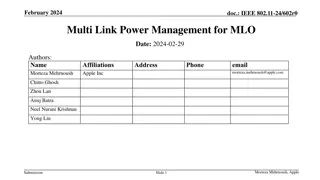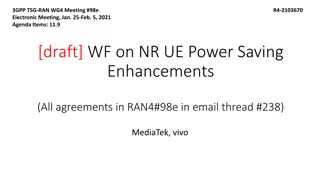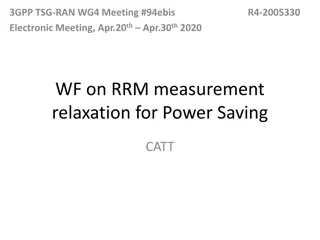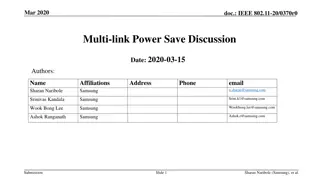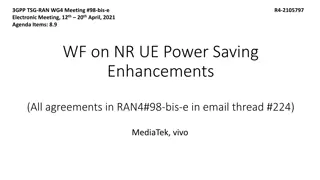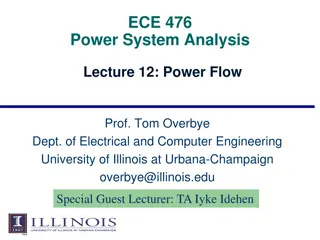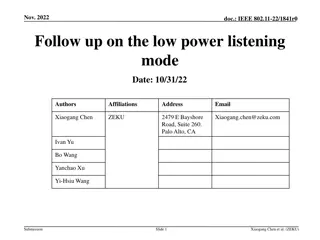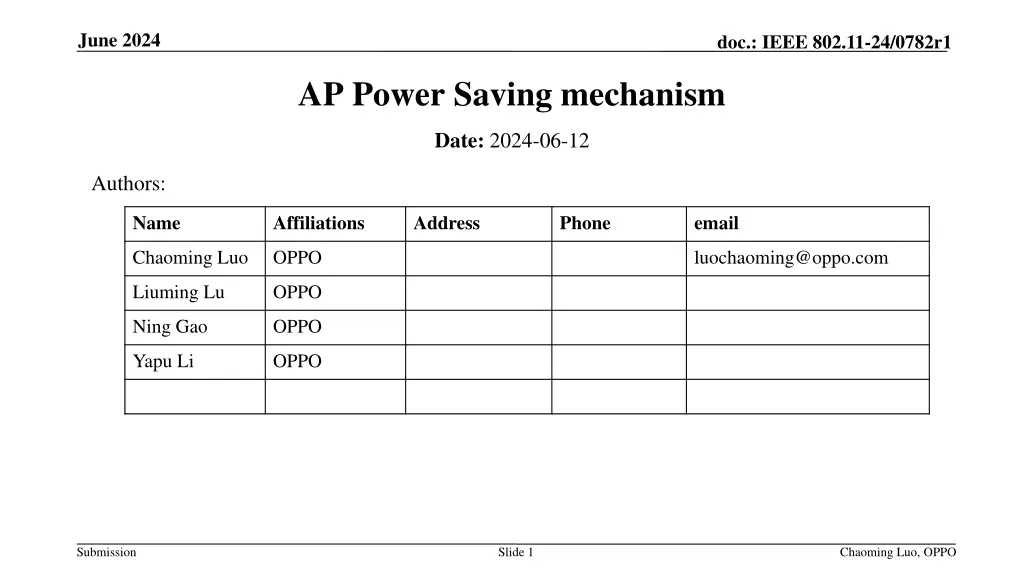
IEEE 802.11-24/0782r1 AP Power Saving Mechanism
"Explore the proposed mechanism for AP power saving in IEEE 802.11-24/0782r1, addressing legacy STA associations, network load considerations, and proposals to enhance efficiency while managing legacy devices effectively."
Download Presentation

Please find below an Image/Link to download the presentation.
The content on the website is provided AS IS for your information and personal use only. It may not be sold, licensed, or shared on other websites without obtaining consent from the author. If you encounter any issues during the download, it is possible that the publisher has removed the file from their server.
You are allowed to download the files provided on this website for personal or commercial use, subject to the condition that they are used lawfully. All files are the property of their respective owners.
The content on the website is provided AS IS for your information and personal use only. It may not be sold, licensed, or shared on other websites without obtaining consent from the author.
E N D
Presentation Transcript
June 2024 doc.: IEEE 802.11-24/0782r1 AP Power Saving mechanism Date: 2024-06-12 Authors: Name Affiliations Address Phone email Chaoming Luo OPPO luochaoming@oppo.com Liuming Lu OPPO Ning Gao OPPO Yapu Li OPPO Submission Slide 1 Chaoming Luo, OPPO
June 2024 doc.: IEEE 802.11-24/0782r1 Abstract Proposes a mechanism for AP power saving, which allows associated legacy STA keeping its association with the AP. Submission Slide 2 Chaoming Luo, OPPO
June 2024 doc.: IEEE 802.11-24/0782r1 Recap AP Power Saving Several AP power saving mechanisms were discussed: Scheduled AP PS and Dynamic AP PS in [1][2]. Scheduled AP PS: Legacy STAs and STAs that don t support scheduled AP PS operate on the AM link (which provides active discovery as well) Dynamic AP PS: the AP must disable dynamic AP PS if there is at least one associated STA that does not support it, or an AP MLD must keep at least one link where dynamic AP PS mode is disabled. Intra-PPDU Power Save and Dynamic SM Power Save in [3]. The protocol needs to address the case when non-HE STAs or non-UHR STAs associate with the AP. AP MLD Power Save in [4]. have only one link operating in the active mode to provide access service to the pre-EHT STA lower capability mode and higher capability mode in SFD [5]. The prior contributions raise a issue of how to deal with legacy STAs associated with the power saving AP. Submission Slide 3 Chaoming Luo, OPPO
June 2024 doc.: IEEE 802.11-24/0782r1 Motivation AP power saving may be enabled if the network load is low. Power saving may results in throughput decreasing. But, the cost should be limited and under control. The AP should control the use of the feature. It does not work well to let AP simply enter doze state. This may cause the associated legacy STAs do frequent retransmission or disassociation. How about let AP always work in lower capability mode? Issue with Legacy STAs. Unfair to legacy STAs that have higher TX/RX capabilities. Forcing legacy STAs to associate/transition to another link (e.g., 2.4 GHz link) may not be the best choice. Put too much burden and exacerbate the contention on the congested 2.4 GHz band. Precluding a STA from association due to PS capability is somewhat unfair to the STA. Submission Slide 4 Chaoming Luo, OPPO
June 2024 doc.: IEEE 802.11-24/0782r1 Proposal Allow an UHR AP to initiate and hold a TXOP w/o DL transmission unless triggered by an UHR STA. (see examples in next slides) The AP contend the channel via CTS-to-self (or a TF, TBD) and enter lower capability mode Using AC_BK or AC_BE (TBD) If the AP does not want to improve low latency, it could enter doze state instead. During the AP s TXOP The AP should not initiate DL transmission unless there is low latency DL traffic arriving in the TXOP. Associated legacy STAs are kept quiet by setting NAV from the CTS-to-self. Associated UHR STAs may backoff and send an ICF (e.g. RTS) to trigger the AP to enter higher capability mode for low latency transmission. Unassociated STAs may backoff and send Probe Request to the AP, AP stays in lower capability mode. (Open for discussion) Unassociated STAs may backoff and send (Re)Associated Request and Authentication frames to initiate association with the AP, the AP switches to higher capability mode. (Open for discussion) Submission Slide 5 Chaoming Luo, OPPO
June 2024 doc.: IEEE 802.11-24/0782r1 Example 1 AP stays in idle and evaporates the TXOP. Lower capability mode Higher capability mode CTS-to- self UHR AP Set NAV, kept quiet Associated legacy STA1 Kept quiet, if it does not support AP power saving, or it has no low latency traffic, Associated UHR STA2 Submission Slide 6 Chaoming Luo, OPPO
June 2024 doc.: IEEE 802.11-24/0782r1 Example 2 UHR STA may backoff and send an ICF (e.g. RTS) to trigger the AP to enter higher capability mode for low latency transmission in the TXOP. The AP could switch to higher capability mode if there is low latency DL traffic that arrives in the TXOP. Lower capability mode Higher capability mode Lower capability mode Higher capability mode CTS-to- self CTS UHR AP Set NAV, kept quiet Associated legacy STA1 shall end before APs TXOP ends ... RTS (non- HT PPDU) Low latency Data SIFS SIFS Associated UHR STA2 Submission Slide 7 Chaoming Luo, OPPO
June 2024 doc.: IEEE 802.11-24/0782r1 Example 3 Unassociated STAs may backoff and send Probe Request to the AP in the TXOP. Higher capability mode Higher capability mode Lower capability mode Probe Response (non-HT PPDU) CTS-to- self DIFS UHR AP Set NAV, kept quiet Associated legacy STA1 Probe Request (non- HT PPDU) Ack SIFS Unassociated STA3 Submission Slide 8 Chaoming Luo, OPPO
June 2024 doc.: IEEE 802.11-24/0782r1 Pros. & Cons. Fair play The AP still use the EDCA parameter in baseline to gain channel access. Does not put burden on another link (e.g., 2.4 GHz). Little to no impact on legacy STAs. Throughput Slightly decrease but still under control of the AP. The AP can use the feature in a opportunistic manner, e.g., when the network load is not high. Limited impact to OBSS: PD-based spatial reuse works well in an idle TXOP. Again, it s under control. It s applicable when there are few neighbour APs. The AP may not use the feature when there are significant contention on the channel. Simplicity Very limited changes to the current specification. Allow the AP to contend and hold a TXOP doing nothing. Allow the UHR STA to trigger the AP to switch to higher capability mode. Slide 9 Submission Chaoming Luo, OPPO
June 2024 doc.: IEEE 802.11-24/0782r1 Straw Poll 1 Do you agree that an UHR AP may initiate and hold a TXOP w/o initiating DL transmission? The AP uses AC_BK or AC_BE to gain the TXOP. In order to save power, the AP stays in lower capability mode by default in the TXOP. An UHR STA may trigger the AP to enter higher capability mode in the TXOP. Detailed signaling is TBD Submission Slide 10 Chaoming Luo, OPPO
June 2024 doc.: IEEE 802.11-24/0782r1 References [1] 11-23-0010-00-0uhr-considerations-for-enabling-ap-power-save [2] 11-23-1965-02-00bn-dynamic-power-save-follow-up [3] 11-23-0015-00-0uhr-ap-mld-power-management [4] 11-23-0225-00-0uhr-considering-unscheduled-ap-power-save [5] 11-24-0209-01-00bn-specification-framework-for-tgbn [6] Draft P802.11REVme_D5.0 [7] Draft P802.11be_D5.01 Submission Slide 11 Chaoming Luo, OPPO
June 2024 doc.: IEEE 802.11-24/0782r1 Reset NAV 10.3.2.4 Setting and resetting the NAV [6] A STA that used information from an RTS frame or MU-RTS Trigger frame as the most recent basis to update its NAV setting is permitted to reset its NAV if no PHY-RXEARLYSIG.indication or PHYRXSTART.indication primitive is received from the PHY during a NAVTimeout period starting when the MAC receives a PHY-RXEND.indication primitive corresponding to the detection of the RTS frame or MURTS Trigger frame. 10.3.2.4 Setting and resetting the NAV [7] An EHT STA that uses information from a received MU-RTS TXS Trigger frame as the most recent basis to update its NAV should not reset its NAV after the NAVTimeout has expired (see 10.3.2.4 (Setting and resetting the NAV)) unless the STA receives a CF-End frame that satisfies the conditions in 26.2.5 (Truncation of TXOP) and 10.23.2.10 (Truncation of TXOP). Submission Slide 12 Chaoming Luo, OPPO
June 2024 doc.: IEEE 802.11-24/0782r1 EDCAF 10.23.2.2 EDCA backoff procedure [6] EDCAF operations shall be performed at slot boundaries, defined as follows on the primary channel, for each EDCAF: At each of the above-described specific slot boundaries, if There is a frame available for transmission at an EDCAF, and The backoff counter for that EDCAF has a value of 0, and Initiation of a transmission sequence is not allowed to commence at this time for an EDCAF of higher UP, that EDCAF shall either choose not to transmit (which results in invocation of the backoff procedure as specified in 10.23.2.2 (EDCA backoff procedure)) or initiate a TXOP. At each of the above-described specific slot boundaries, each EDCAF shall do nothing if There is no frame available for transmission at that EDCAF, and The backoff counter for that EDCAF has a value of 0. Submission Slide 13 Chaoming Luo, OPPO



